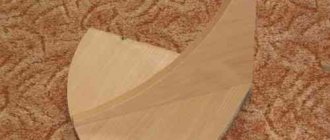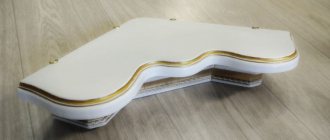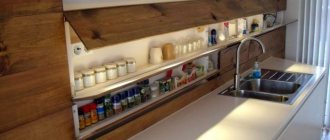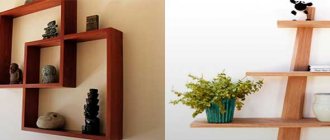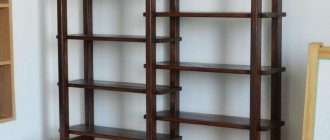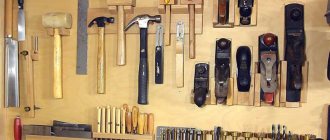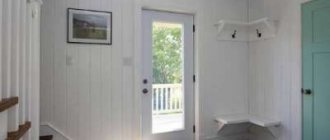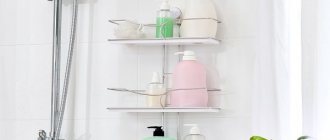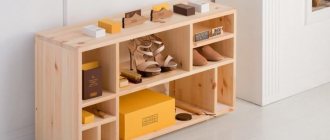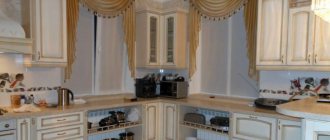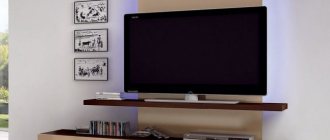It is difficult to imagine the interior of any room without shelves. It would seem that it is already difficult to come up with new shapes or combinations in shelf designs. However, the restless design thought does not stop there. Creative solutions create new models and help reveal unexpected advantages in them.
White corner shelves
Decorative corner shelves
Advantages of corner shelves:
- practically do not take up space and do not clutter up space;
- increase the functionality of the environment;
- ease of manufacture, the ability to assemble models yourself from scrap materials;
- complement the interior of any room;
- It's easy to choose a model for all design styles.
Corner shelves for decoration
Corner wooden shelves
Tools and materials
At different stages of the work you will need materials and tools for drywall. The raw materials must be carefully prepared so that the process can proceed without interruption.
| Work stage | Tools and materials |
| Drawing up a drawing diagram | Paper. Pencil or pen. Ruler or tape measure. |
| Surface marking | Plumb or level. Laser pointer for measuring differences. Corner for marking profile joints. Pencil or marker. |
| Assembly and installation of the frame | Profiles (guides) for complex structures that carry a large load, rack-type profiles will also be required. Self-tapping screws for drywall of the selected diameter. Screws and screwdriver. You need to buy a knife or metal scissors. |
| GKL sheathing | Plasterboard sheets of selected diameter. Drywall knife. Screwdriver and screws (self-tapping screws) for fastening profiles. |
| Sealing joints between sheets | Putty (dry, which needs to be dissolved or a ready-made mixture). Special reinforcing tape for sealing joints. Putty knife. Sandpaper for smoothing out uneven surfaces. |
| Finishing | Paint. Wallpaper for gypsum boards. Primer mixture. Putty knife. Glue. |
Having acquired all the above materials and tools, the process of creating corner shelves will be easy and quick.
Materials for making a corner shelf
Such shelves can be made from different materials, and here you need to take into account the interior of a particular room. Somewhere shelves made of fiberboard look great, in another place homemade solid wood with antique processing will fit well into the style of the room, but our MAKE company offers a shelf made of a window sill profile (18-25 mm thick). This material will not create problems in operation, it is easy to clean, does not fade under the sun and is not susceptible to rotting.
To do the work yourself you will need:
- — Window sill profile (inexpensive, easy to buy),
- — Drill, screwdriver, level and hacksaw,
- - Several self-tapping screws,
- — A wooden strip and glue for fixing it with plastic.
Floor
Elements of the modular system, shelving, and shelves rest on the floor. Such shelves can be located anywhere on the floor. The main thing is that their location does not interfere with movement around the room.
In small bedrooms, for a more rational use of space, instead of bedside tables, it is better to use low and narrow racks or light shelves.
Wall-mounted corner shelves.
We will make corner shelves with our own hands for all corners of the room at once. They can be used as corner shelves for speakers, candle holders, flower vases or anything else.
If you have already made a wall shelf for your equipment or hung your TV on the wall, then corner shelves will be an excellent addition to your interior.
In my case, decorative candlesticks are located on two shelves, and the rear speakers of the audio system are on the second.
To make corner shelves, we will need a piece of laminated chipboard to match the color of the interior, preferably to match the color of the interior doors. If you decide to make four corner shelves, you will need a square of approximately 680x680mm or another size at your discretion. In addition, you will need an edge, preferably vinyl rather than melamine. Tools – jigsaw. First, one secret - do not trust builders and do not believe that the corners of your room are 90 degrees each. It may turn out that one pair of diagonally opposite angles is acute, and the other is obtuse. This is what happened in my apartment. This should be taken into account when marking the sheet.
After the sheet is marked, it must be cut into 4 parts. Then carefully cut out the rounded edges with a jigsaw. We use a saw with a fine tooth so as not to crumble the laminate.
Please note that we will not have any waste. The part that is cut off from the outside will be the stand at the bottom. After cutting out the blanks, use a low-heated iron to glue the edge. After this, using screws, we assemble the upper and lower parts, having previously made and attached fasteners to the shelf.
The fasteners are plates with slots. They are screwed to the ends of the shelf with screws. Opposite the slots in the shelf itself, we make recesses for the heads of the screws on which the shelf will be attached.
We hang the shelf on two screws screwed into the plugs in the walls. We mark the places for the screws by laying the shelf in the corner. That's all - the shelf is ready. When hanging a shelf with screws, remember the main rule of a new home - “A screw driven into a wall with a hammer holds better than a nail screwed with a screwdriver” (joke). Such corner shelves are very easy and quick to make. They look quite nice and neat. At the same time, they complement the interior of the room and carry a functional load. If you liked the article, leave the link on your social network. Also see how to make: Shelf for equipment
Leave a comment
Book shelf
On the Internet you can find a huge number of photographs of book shelves. But the execution algorithm is more or less the same for everyone, it only differs in the addition of new modules.
Take, for example, the type of labyrinth. We take standard tools. The marking is done exactly as described earlier. Trimming headers is a bit more complicated. All boards are cut at a 90 or 45 degree angle, whichever you prefer.
If you decide to do the second option, then be sure to use a miter box to make symmetrical cuts, otherwise you will not achieve the desired result.
The product is easy to assemble - glue the sections together, secure each corner with special slotted furniture screws (two for each corner). Then attach it to the wall.
Interesting wooden shelf. Master Class
You will need:
- Rope;
- Board at least 2 cm thick;
- 2 corners (mounts) for shelves;
- Steel washers;
- Lighter;
- Drill;
- Saw.
Today, even the most modern and fashionable designer does not take advantage of the opportunity to use practical and stylish shelves when decorating the interior. They will not only become an integral part of the future decor, but will also serve as an excellent stand for books (mount for bookshelves), for photos and decorative items.
There are two types of shelf mounting available:
- standard method (using hinged brackets, corners, etc.);
- fastening shelves to the wall without visible fasteners.
We will look at the first method in more detail, since with the standard design it is difficult to achieve a combination of the future interior with the target design.
- Preparation for fastening
- Detailed mounting instructions with photos
Let's consider the process of preparing the fastening
- First of all, you will need to assess how reliable the wall is where our shelf will be mounted. If it is a brick wall, then it should be at least 25 cm thick, and if you have a concrete wall, then from 10 cm, which will allow you to place not only decorative elements on the shelves.
1 – fastening element;
2 – holes for installation;
3 – metal rod;
4 – hinged bracket;
5 – shelf.
2. After this, we move on to determining the thickness of the future shelf.
To do this, you must know exactly what will be placed on the shelf so that there is no deflection or deformation. You can check this simply by taking a board of approximate thickness and placing a weight on it.
- If the interior concept requires thicker boards, then in this case everything should be used according to the recommendations of your designer or the chosen style.
- You will need to take into account the mounting features, since the thickness of the shelf cannot be less than 3 cm. If books are placed, it is better to use a thickness of 4.5 to 6 cm.
- The future shelf will need to be thoroughly dried and soaked before processing.
How to install shelves to a wall without visible fasteners
Step 1. Measure the distance between the holes.
Step 3. After this, we apply our fastening element to the resulting axis and mark holes for it, which should be located on a horizontal line.
Step 5. After this, we clean all the holes from any remaining shavings and dust and drive wooden pegs or plugs under the dowels.
Step 6. After this, take dowels or screws and screw the fastening element to the plugs or pegs.
Step 7. After this, we proceed to installing the shelf itself on the fasteners. If the shelf does not fit very tightly, you can tap it with your palm or a rubber hammer to securely fix it. It should be noted that you need to knock alternately on the left and right, this way you will prevent the shelf from skewing and it will sit evenly on the fastening element.
The problem of free space is always relevant, especially for small apartments. What to do if you want to place your favorite books or children's crafts? Corner shelves will help out.
Almost always in the apartment there is an unoccupied free corner in which a rack or small shelf would be perfectly located. This will free up some space and also add a new decorative element.
Stylish corner shelves photo
The kitchen, bathroom and hallway are the most problematic rooms in the house in terms of the need to store a large number of small items. Thick floating shelves are already a fashion trend, but open corner shelves are also a huge space saver and make the room look freer.
In the hallway, corner shelves can simultaneously serve as a stylish clothes hanger or a stand for bags and shoes.
Tall and narrow floor-mounted corner shelves can look very elegant even with the simplest decor.
Also read:
At the same time, some corner shelves can have a very stylish and original design that will catch your eye and transform the entire shape of the space.
Also read:
In the last photo you can see how corner shelves can act as a home office (left) or a simple decoration for the living room. And the following images show you some truly amazing corner shelves that line the corners between walls in hallways and other spaces.
We hope that after these photos you no longer doubt that corner shelves can help make your interior design more functional and interesting. It remains only to note that beautiful corner shelves, like any piece of furniture, can be made by you yourself (see photo below). Thank you for reading Dekorin!
Corner shelves in the interior allow you to optimize the use of space in the room, expand its functionality and increase ergonomics. The space gets rid of massive furniture, which adds more volume and functional practicality to the structure of the room.
Home design using corner furniture designs looks aesthetically pleasing and adds style to the decor of the room.
On the corner shelves it is possible to successfully place non-bulky household appliances, dishes, books, souvenirs, paintings, photographs and other small items. Thus, corner shelves effectively solve the problem of placing things in a limited space of the home.
Table in front of the window
It is very important to position the table correctly relative to the window. You should not sit with your back to the window because you will block out the light and, in addition, reflections in the computer monitor will interfere with your work.
The monitor should be located on the side of the window at a distance of at least 1 m, and the minimum proximity of the working person to the screen should be 40-75 cm. If you are right-handed, then the light source should come from the left, while for left-handed people - from the right. Then the shadow of the writing hand will not interfere or interfere.
However, if the tabletop is located parallel to the window, then you should take care of appropriate curtains or blinds that limit too harsh sunlight that strains the eyes. If you plan to study or work mainly in the evening, do not forget about good additional lighting, which should apply the same principles as for natural light.
Depending on the layout of the room, it would be good if you placed a desk in front or to the side of the door so that you can monitor what is happening outside the room.
Step-by-step instruction
- An ordinary board left over from the renovation will be suitable as the main material. The width should be selected individually, based on the items that will be placed on it and the place where it will be installed.
- In addition, for fastening you will need glue with a dispenser and screws (3.0x25 mm). Semicircular slats can be used as decoration.
- We mark the board at a 45° angle to the required length and use a hacksaw to cut it at an angle of 45°. As a result, we get 4 shelves.
- From the remains of the board you need to cut out racks of the same size (for example, 5x20 cm) in the amount of 6 pieces.
- All elements should be sanded until perfectly smooth.
- Let's start assembling the structure. Each shelf, except the top one, must be secured with two racks. The markings are applied in the middle, then the elements are fastened with screws. To strengthen the fasteners, use PVA glue.
- For ease of fastening, the middle shelf posts are placed along the edges.
- The remaining parts of the corner shelf are assembled in the same way.
- If you wish and have free time, you can decorate the shelves using semicircular slats. So, with their help you can make low handrails so that small or round accessories do not fall out. At the final stage, the shelf is painted.
Preparation of the drawing
An important stage of independent work is the preparation of a drawing, according to which further assembly of the structure will be carried out. The following parameters must be displayed on the diagram:
- General dimensions of this accessory.
- Dimensions of supports and horizontal strips.
- Assembly features.
It is important to identify any additional details: built-in spotlights, doors and mirror facades, fixing devices and limiting edges.
Place corner shelves in different rooms
You can install a corner shelf in any room, but in most cases it is great for the kitchen or bathroom. Any housewife will quickly place on it a variety of jars with seasonings, cereals and other kitchen utensils, and in the bathroom such a shelf near the mirror will allow you to accommodate all hygiene products and free up the necessary drawers. It is worth noting that these rooms have a fairly high level of humidity, which means that the wood will need to be additionally treated with antiseptics and at least two layers of paint applied. The best option would be plastic or glass, as they have more advantages:
- resistant to moisture and temperature changes;
- mold and fungi do not appear on surfaces;
- withstand heavy weight;
- easy to clean;
- A variety of colors will allow the design to fit into any interior.
Also, corner shelves on the wall are a rational option that is suitable for bedrooms, children's rooms and living rooms. Any other furniture can be placed under the shelf, for example:
- nightstand;
- computer desk;
- armchair.
Regardless of what material was used, the design will look impressive and presentable. The corner shelf will conveniently accommodate all sorts of little things: books, photographs, dishes, candles, toys and much more.
Niches
They come in a wide variety - round, oval, square, rectangular, narrow, wide, large and small, anywhere on the wall and at any height.
Niches may appear as a result of construction or design during planning. It is very easy to install shelves in them, from any material. If the niche is long, the material must be selected taking into account the weight of the items that will be placed on the shelves.
Corner shelves in the interior
Shelves with corner mounting to the wall are installed in all types of residential and office areas. In the dining room mezzanine, it is advisable to install it directly near the working area and use it to protect kitchen utensils: dish sets, containers for bulk substances and seasonings.
The lightness and convenience of the design of corner shelves makes them a good alternative to corner cabinets. On the one hand, room space is saved, on the other hand, beautiful dishes, souvenirs and other interesting items are located in an accessible and open place for viewing.
Corner shelves are indispensable for decorating a workspace in a home office or office. The shelf of this model will successfully fit into the business interior of the room, filling the free corner space. This allows you to concentrate the things necessary for work in a limited area.
In places with limited space, this furniture layout is an ideal solution. The design of the room, complemented by a corner shelf, creates an excellent environment for relaxation and intellectual time spent reading books. The furniture corner can be decorated with flowers, which are best placed on the top floors of the structure. This greatly refreshes the room and adds coziness and sophistication to the atmosphere. Shelves placed in the corners are relevant in the design of book depositories in homes.
Corner shelves are not only compact and practical, but can also amaze with their stylish and aesthetic appearance.
Beautiful and original bookshelves will create coziness and comfort in the family library, demonstrating the sophistication of your taste and creative imagination. Unusual corner bookshelves, in addition to storing books, can be a wonderful decoration for the interior of a library.
Modules
From such shelves you can create any compositions of various shapes and sizes, placed near the wall or anywhere in the room.
Individual modules can be very different - rectangular, square, round, small and large.
They can be placed on top of each other or side by side, in one or several rows, and can also be attached to the wall. This option is ideal for those who like to make rearrangements.
Manufacturing process
The wall-mounted corner shelf will serve for all small accessories that constantly fall: keys, lipsticks.
You can consider the option, if, of course, space allows, to make several shelves on top of each other. This will more compactly distribute the location of various small things. At an angle of 45°, measure the distance on a wooden board, which will be equal to the length of the corner of the wall where the wall-mounted corner shelf will be installed.
Using a hacksaw you need to cut out the body of the future design. You can also use an electric jigsaw. After cutting, the edges of the shelf need to be cleaned using sandpaper. Cleaning is carried out until roughness is completely eliminated.
The next step is cutting the racks for the corner wall shelf. If it is one shelf, then two slats need to be cut. The slats should be small, the width and length should match the length of the shelf. In order to prevent anything from falling from it, you need to make sides out of slats. They may look like balcony railings.
Tools needed for work: hammer, hacksaw, sandpaper, universal screws for fastening.
The next process is installation on the wall. Two thin slats need to be nailed to the wall. If the wall is tiled, then you need to use a drill and dowels. The slats are the basis or fasteners for the corner structure. You need to connect the body of the structure with the slats with glue. After coating the top edges of the slats with PVA, place the shelf on them. You need to wait a day for the structure to dry, or use liquid nails for a quick connection.
To give an aesthetic appearance to the wall corner structure, you can paint it with gold paint. If you plan to create several (standing on top of each other) shelves, then this process will require additional cut racks. That is, the arrangement of wall-mounted corner shelves is as follows: the base of the shelf, and two racks on each side. The next base is placed on four posts. The next level requires only two racks. And so on. The number of racks for stability needs to be changed each level. The wooden components must be connected to each other using glue and nails.
https://youtube.com/watch?v=7iL8HE0ZMSg
This corner wall design will serve as a home for all the small items that constantly fall: keys, lipsticks; in the bathroom - shampoos and toothbrushes.
Another type of corner wall structure can be made with your own hands. To do this you will need to use an MDF sheet, a milling machine, a jigsaw, a drill and drill bits, and self-tapping screws. You need to cut a circle from an MDF sheet, having decided on the size in advance and dividing it into equal 4 parts. After the circle is cut out, it is cut into equal parts. That is, it will turn out that two sections of half a semicircle will be adjacent to the wall. The third section is the base. The fourth is a mini-shelf in this structure.
The size of the mini-shelf must be calculated when the structure is already assembled. Then you need to connect the built-in mini-shelf to the base using nails or screws. It is also possible to use liquid nails, but in this case you will need to wait until the structure dries. After all work is completed, the product must be painted for aesthetics. It is attached to the wall using dowels and screws. It turns out a beautiful and stylish corner shelf, made by yourself.
Pros and cons of shelves
Any design solutions have their positive and negative sides.
One of the important advantages is the variety of shelves, which means a very reasonable price for the products and the ability to install them without much difficulty.
Thanks to the openness of the structures, you can visually unload the space, and vice versa - fill it, you can also quickly get to the objects located on them.
Shelves and racks can be easily mounted on walls, including those made of plasterboard. Even if they carry some load, their use is often much more rational than installing a large cabinet. Shelving and modular systems are generally very mobile options with which you can change the environment every day.
There are also negative aspects - open surfaces get quite dusty. Therefore, there is a need for regular thorough cleaning - especially for niches. The use of glass doors eliminates this problem quite well, but makes the structure heavier. For niches, this fact is not important.
And one more point is the possibility of objects falling, so it is advisable to use all kinds of limiters. In particular, this applies to shelves mounted above the head of the bed.
And remember - to store documents, dangerous objects (knives, cartridges, flammable liquids, etc.), underwear and jewelry, it is wiser not to use open shelves.
How to choose a corner shelf
The choice of corner shelf depends on the size of the room. If there is enough free space, the shelves can be installed anywhere in the room, without particularly thinking about the method of fastening. If there is a shortage of space in the room, it is advisable to use corner structures for attaching racks and shelves. They can be placed in any suitable place, even placed above the furniture standing in the same corner.
Corner shelves with lighting elements will look great in the living room
This constructive solution visually divides the space and focuses attention on certain areas of the room.
Shelves arranged in a chaotic manner look good, but this option requires a thoughtful design.
In a children's room, a corner furniture structure in the form of a shelf will effectively solve the problem of optimizing the play space for a child. Decorate your baby's room with educational details and visually expand the space, making it more comfortable.
Corner shelves are also appropriate in the bedroom. They have a decorative purpose and reflect the individual taste of the owner of the home. Wooden shelves are better suited for a bedroom.
Decorative shelves for rooms and other rooms
They are usually made of wood or plastic and decorated with a variety of shapes. Their length usually does not exceed 0.6 m. They can be installed in empty corners in the room or kitchen. Such shelves are used to place decorative dishes, various photographs, and small framed sketches. In the children's room, small toys are placed on them. For such shelves, you can use segments cut from a large diameter plastic pipe, installed at right angles to each other. You can put one or two light objects on it.
There is another type of such structures.
They are used to install icons in the corner of the room.
They are usually made of wood or plastic and decorated with a variety of shapes. Their length usually does not exceed 0.6 m. They can be installed in empty corners in the room or kitchen.
A variant of such a decorative shelf is a three-tier corner module, the elements of which are finished in an antique style. Each floor of the structure serves its own purpose: on the top shelf there is the largest icon, on the middle section there are small ones, and on the lowest plane there are candles. The width of such a module does not exceed 30 cm. The entire structure is covered with carvings and decorative elements, which form a cross in the upper part. The classic form for such shelf structures is a two-tier module. The lower floor is made wider than the upper one, and structurally consists of 2 shelves, which are connected by supports. On the second floor there is a wide plane, covered on top with an element in the form of a house roof.
Another option for decorative structures of this type is shelves for flowers. They can be placed in the room, kitchen, balcony, loggia. They are usually made from plywood or plastic. The design of a flower shelf in the form of steps, which are formed by small wooden planes connected at one of the edges by metal tubes or wooden cubes, is very practical. Many pots with plants can be installed on such a structure, since the ladder that starts on one wall rises to a height of up to 1.8 m and then, turning 90°, descends along the second wall. But usually there is not so much space in the room, so shelves for flowers are usually made two-tiered. You can hang them from the ceiling using straps.
Another option for decorative structures of this type is shelves for flowers. They can be placed in the room, kitchen, balcony, loggia.
Corner shelves for bathroom
It's no secret that most bathrooms are small in size, and the issue of saving space is very acute. But in this room you should conveniently place bath accessories, shampoos and shower gels, cosmetics and perfumes, as well as all kinds of detergents for washing and cleaning.
That is why various hanging structures are simply irreplaceable here. The best option is to hang the corner ones on the wall. They go well with mirrors, look elegant and suit almost any bathroom decor. And if you consider that the humidity in this room is always high, then you cannot find a better material for shelves.
Although plastic shelves would be no less appropriate here. Their design consists of a stand, which is installed in the spacer between the edge of the bathtub and the ceiling, and four shelves with perforations (for water drainage). For convenience, the shelves are equipped with hanging soap dishes and hooks for washcloths.
Also in the bathroom you can hang corner shelves on a metal wall. Such structures are usually made of stainless or chrome-plated steel.
Accommodation
You can use any part of the room for shelves; it is only important to determine the functional need for their location in one place or another.
Small shelves for projectors are most often attached to the ceiling, but this option is not very appropriate in the bedroom, so it is not worth considering.
You can also attach metal or wooden racks for shelving installed between it and the floor to the ceiling.
Corner shelf materials
Corner shelves made of plastic, organic glass or chromed metal are ideal for the bathroom. The choice of material for making shelves is influenced by the overall design concept of the room. The texture of the material must correspond to the functional purpose of the room.
This makes it possible to individually design a room and decorate certain areas of the home in an individual style. Corner shelves can be decorated with LED lighting built into the structure or small spotlights.
Shelves are fixed to the wall in different ways - hidden and decorative. To decorate corner furniture structures, cables, stones, chains, and textile materials are used.
Despite the fact that corner wall shelves are the simplest furniture design, the role of these pieces of furniture in organizing human life inside the home is great. In addition, they perfectly solve the issue of saving space, increasing its functionality and practicality.
The possibilities of this piece of furniture in decorating a residential or office space are unlimited. For almost any interior, a wall shelf is universal and will organically fit into the space, turning an apartment, office, room with any purpose into a stylish and ultra-modern place.
Shelves in the house are one of the most optimal rational ways to use free space. They can act as a separate design feature and at the same time successfully accommodate many necessary things.
Corner shelves on the wall are especially popular among owners of small living spaces, where you need to place a lot, but there is not enough space. The modern market offers many variations of them, ranging from plastic corner shelves for the bathroom to real works of art in the form of wooden or glass structures. We will now tell you how to use such comfortable and practical furniture in your home.
Corner shelves for the kitchen
We spend a lot of time in the kitchen, so an atmosphere of comfort and warmth should reign here. However, it can be difficult to complement the interior with some decorative items because in the room where food is prepared there is always a lot of kitchen utensils that should be placed in the most convenient way. This is exactly what corner kitchen shelves are for. They help turn wasted space into a very useful department.
In order not to place a hodgepodge, a sugar bowl, a pepper shaker, a set of jars for seasonings, spices, cereals, a vase with fruits or sweets, and much more all over the desktop, it is enough to install a multi-tiered wooden corner shelf for the kitchen on the wall, and all this will be collected in one secluded place. You can also store large vases, bowls, flower pots on it, it looks very original and modern. It is very convenient to use corner shelves made of plasterboard. They need to be “built” manually, but the result is pleasantly pleasing because such a design can serve as a corner shelf for a TV in the kitchen, and just a place to place kitchen figurines, candles, paintings, children’s crafts or favorite photos.
Corner shelves on the wall for the living room
When choosing shelves for the most important room in the house, it is very important to take into account the overall style of the interior. Made from wood or chipboard in a trendy dark brown wenge color, corner shelves will give the room a feeling of luxury.
They blend harmoniously with furniture of the same color in the living room or study. A multi-tiered white corner shelf can also become a light, unobtrusive decorative element in the living room. Both options are suitable for storing family photos, lamps, awards, decorative items, books, magazines, etc.
Corner shelves for flowers
This piece of furniture is very popular among all home “amateur gardeners”. Corner shelves for flowers are made mainly of metal, wood or chipboard. Forged shelves attract with their flexible lines, original shapes and are able to support the largest pots of greenery. Wooden
103583
Window sills
The space under the window can be a great place for a small shelving unit that can be mounted on the wall or “tied to the window sill.”
On the shelves you can store, for example, threads and needles, covering them with a door, or leave them open, placing photographs in frames or decorative candles.
DIY shelves, varieties of designs and interesting ideas for use 115 photos
Light, neat, interesting wall shelves, which are an excellent alternative to bulky cabinet furniture, will be an excellent decoration for any interior. Assembled from specially purchased ready-made blocks, or made from scrap materials available in every home, these products will bring comfort and originality to any room.
Beautiful shelves will find their application in any room of the apartment, be it the kitchen, living room, bedroom, hallway or bathroom. With their help, the room will look more lived-in, interesting, and there will be additional space for storing any useful items.
A shelf for heavy objects, for example, books, an aquarium, collectible dishes, potted plants, should be as reliable as possible, made of solid materials.
Therefore, before starting the process of designing a shelf, be sure to consider the following details:
- full load on the structure;
- fastening method;
- compliance of the materials used with the purpose of the room in which installation is planned;
- product style and design;
- functional.
When wondering how to make a wall shelf with your own hands, first decide which type of future design will be more suitable for the chosen room and will fully correspond to the assigned functions and your preferences.
Based on design features, shelves are:
- closing and fully open;
- linear and L-shaped;
- with or without side fencing elements;
- through, or with a rear limiter;
- single-tier or having several levels;
- round and rectangular;
- unusual shape, steeply inclined, diamond-shaped;
- limited on all sides or consisting of one base, etc.
If you pay attention to the materials used for manufacturing, then wall shelves can be:
- glass;
- with mirror surface elements;
- wooden;
- made of MDF, chipboard, plywood;
- polymer and plastic;
- combined - using several types of raw materials.
Think about which materials will be most preferable for constructing a shelf yourself, more wear-resistant and reliable, and choose an option that suits you with all its characteristics.
After studying numerous photos of shelves made by yourself, you can choose the option that best suits your taste and take it as a sample, try to make the most similar design, adapted specifically to your apartment.
It is best to adhere to the following algorithm of actions:
Draw a rough sketch on paper, indicating the planned dimensions of the shelf, or even better, a full-fledged sketch of how the future shelf will look on the wall, indicating its dimensions.
Decide on the type of fastening, whether it will be construction dowels, anchors, brackets that can withstand heavy loads, or whether the shelf will be attached to a flexible base, for example, flagella, braided ropes, belts - these fasteners are only suitable for lightweight ones used primarily as a decorative element , shelves
Cut the materials to the required sizes, or, if using store-bought blanks, prepare them for assembly. Proceed with the immediate assembly of all parts and components, attach brackets, hinges or other prepared fasteners to the shelf.
Make horizontal markings on the wall surface to ensure even mounting to the wall. Attach the finished structure to the place allocated to it, check the strength of the structure.
The process of making a shelf with your own hands has come to an end, now all you have to do is display your favorite collection on it, lay out a set of books or any other items for which the shelf was intended.
Shelf with straps - to assemble it you will need two flat boards and two strong leather straps.
An invisible bookshelf - you will need several steel brackets on which the books are placed. Looking at this design, it seems that the books are simply floating in the air.
A wall shelf made of water pipes will be an excellent decoration for interiors of special styles.
Floor shelf made using glass bottles and base boards.
There are a huge number of variations in the design of wall shelves, because such a piece of furniture can be made from almost any material at hand. Turn on your imagination and begin the creative process of creating an unusual, aesthetic and functional piece of furniture.
Original do-it-yourself shelves, how to make book shelves, hanging shelves, kitchen shelves 90 photo video
Shelves are often used not only to complement and decorate the overall interior of the room, but also for a clearer and more expedient organization of space. Thanks to their use, the apartment owner has the opportunity to conveniently arrange a huge number of small things that would simply get lost in closets.
Today, there are a lot of different models on the market that are made of different materials. They also differ in design.
You can choose not only products with classic designs, but also ultra-modern designs.
But more and more often people prefer to make such interior details themselves. Wondering how to make a shelf with their own hands, they re-read a lot of literature and look through many catalogs.
However, this does not mean that making a shelf yourself is difficult and is beyond the capabilities of a person who does not have special skills. No, that's not true at all.
In this case, familiarization with the literature is necessary in order to create a product with a beautiful design that will fit into the overall interior. Let's take a closer look at what kind of shelves there are.
The most popular and widely known subtype of shelves is the classic shelf. This is due to the fact that it is quite easy to install, and the appearance, thanks to its simplicity, seems refined and sophisticated.
Both open and closed shelves are used successfully. Closed products are most often used for decoration and installation in rooms decorated in more modern styles. Glass and sometimes plastic are used to construct them.
Open structures can be used both in modernly decorated houses and in apartments with a classic design. Over the past few years, this particular type of shelf has gained enormous popularity and is therefore gradually replacing the classic options.
In small rooms, you can often see corner shelves that have a special method of fastening. They are mounted on adjacent walls that are adjacent to each other. They are most often used in bathrooms, kitchens and utility rooms.
They are installed using cables and vertical posts, and attached directly to the ceiling. This mount looks quite unusual and original.
Floor structures are most often used in hallways. After all, hand-made floor shelves for shoes not only look beautiful, but also help you organize the space of a small hallway. At the same time, making them is quite simple.
To create the claimed product, you should purchase or prepare some tools and materials in advance. As connecting elements, you can use whatever suits you best. But the most popular are ordinary screws, brackets and dowels.
For example, let's take a photo of the shelves with our own hands, which is presented below. It shows a product with the following parameters: width 250 mm, height 300 mm, length 1100 mm. For convenience, the manufacturing process will be divided into stages.
This marking is optimal because the side walls will be located between the two parts.
At the third stage, you can begin processing the resulting workpieces. The resulting sections should be coated with a special protective varnish or stain, having previously sanded them.
If you only plan to paint the shelf, you can get by with treating it with a regular antiseptic primer. This way you will not only increase the service life, but also achieve a more uniform distribution of paint.
At the fourth stage of making a wooden shelf with your own hands, you begin to directly assemble it. The bottom board should be laid on a flat surface. Step back 8 mm from the ends of the workpiece and draw two lines parallel to the cuts.
After this, you should install the side blanks on the lower section of the board and secure them. Once you are done with attaching the side panels, proceed to install the top panel and secure it.
At the fifth stage, you should attach the brackets to the ends of the side panels, and make several holes in the wall for the dowels. After this, screw in the screws so that they protrude by 5 mm. And now your shelf is ready.
Features of homemade furniture for home
Today, the production of home furniture has reached the peak of its popularity. Handmade furniture has a high cost, because the most incredible designs are made to order.
In addition, the advantages of home construction of a shelf or rack include:
- Availability of all materials and tools used.
- Large collection of step-by-step instructions, video lessons, ready-made drawings. If necessary, you can select and print a diagram of a wall-mounted corner shelf or floor rack suitable for independent work.
- When carrying out construction work, the master has the opportunity to independently adjust the height of the shelf, width and depth, the size of the openings between adjacent levels, the external design and materials for the manufacture of the structure.
- If desired, you can make the structure quite mobile or, conversely, a stationary model. The photo of DIY corner shelves shows how you can attach small wheels to the bottom bar of the shelving unit (great for a bathroom or kitchen). This model is especially convenient for modular assembly of the frame.
Beautiful furniture with an original design can be used for zoning, for example, in a studio apartment.
- In a children's room for two children, an open-type shelving unit will become an indispensable assistant, and parents can paint the side facades with bright colors together with their children.
Selection of materials for work
The main task of the master in independent work is to select consumables. To date, the most optimal options are recognized:
- Wood.
- Chipboard panels.
- Sheets of plywood.
- Combination of profiled iron and tempered glass.
The combination of profiled iron and wooden panels is also very popular. Each of the presented materials differs in its properties, assembly features and rules of practical care. Wood has the safest and most durable structure.
Species such as ash, oak, and alder do not contain caustic resins and are quite resistant to moisture. If properly impregnated during shelf construction, the surface of the wood is not susceptible to rotting and mold development.
- Chipboard panels and plywood are slightly inferior in strength to solid wood.
- In the production of panels, wood chips and polymer resins are used, which are safe for the health of others, including children.
- These materials also do not cause allergic reactions, are perfect for subsequent decoration, and serve for a long time in everyday life.
The use of combined materials, such as wood, metal and glass, not only requires significant financial costs. In addition to the high cost, such an approach to work requires a detailed approach from the master and experience in handling many tools (grinder, welding, plane for grinding surfaces, glass cutters).
However, with the right approach, the interior of the apartment will be decorated with an incredibly stylish shelf with decorative coating on glass or a structure with a chrome frame and wooden plates.
Preparing tools
The simplest model for home construction is a floor-mounted corner shelf made of wood and profiled iron. This furniture does not have fronts or a back wall, which greatly facilitates practical care and the work process itself.
The master needs to prepare:
- Planer and sandpaper for sanding surfaces.
- Jigsaw.
- Welding and a grinder will be useful when assembling the frame.
- Antiseptic, antipyrine and moisture-resistant oil are used to impregnate wooden surfaces. It is especially important not to skip this stage when making a corner shelf for the kitchen with your own hands.
- Self-tapping screws or thermal washers are used as fasteners, which do not damage the surface layer of wood as much.
We should not forget about decorating compounds, for example, stain, acrylic varnish and paints.
- PVC films with imitation of various materials and photo printing, which are attached to the side walls of the structure (if provided by the selected model), are very popular today.
Step-by-step instruction
The first task of the master is to prepare a drawing that will show the dimensions of the structure, the depth and height of each tier, the frame model, and the fasteners used. Having prepared the materials and tools, as well as your workplace, you can begin to work.
Instructions on how to make a corner shelf with your own hands:
- Based on a drawing prepared in advance, parts are cut out for subsequent assembly. Each shelf must have a strictly defined size, which is adjusted using a tape measure.
- All existing irregularities and gaps are eliminated by grinding (consistently using a plane and then sandpaper).
- Next, they begin to impregnate the surfaces with moisture-resistant oil, which will prevent the development of mold and rotting of the wood.
- While the exposure time is maintained, you can weld the metal frame.
- The structure is welded in such a way that the metal base for each shelf has slightly smaller dimensions than the wooden plate itself. With this approach, wooden sheets fit tightly to the metal support without forming defects.
- Important attention is paid to the base of the metal frame. It is necessary to ensure that the corner rack has sufficient stability and does not tilt to the sides.
- The surfaces of the frame are coated with an anti-corrosion compound and then painted in the chosen color.
- After the paint and impregnation oil have completely dried, they begin to assemble the L-shaped shelf. For fastening, use thermal washers or screws of sufficient length.
For the shelves themselves, you can come up with very original ways of decorating, for example, carving or wood burning.
- Painting with acrylic paints or artificial aging of surfaces using pearlescent paint is also often used.
Photo of a homemade corner shelf
Hanging shelf with straps
If you need a decorative shelf for small items, the following option is perfect - a board suspended on straps.
To make a shelf you will need:
- 2 edged boards 300x750 mm, 30 mm thick;
- 4 leather belts, 75 cm long;
- 4 long screws with plastic dowels;
- 4 short screws;
- building level;
- ruler;
- sharp knife;
- drill.
Step 1: Preparing the belts
The cuts of the belts must be perfectly even, so if necessary they are trimmed with a knife. Fold each belt in half, press the ends to the table, step back 2 cm from the edge and drill a neat through hole with a drill. The same is done with the remaining three.
Step 2. Attaching the straps to the wall
Using a level, two points are determined on the wall at a distance of 60 cm. Holes are drilled and plastic dowels are inserted. The belt folded in half is applied to one of the holes and secured with a long screw - you get a large loop on the wall. Another such loop is attached nearby.
Step 3. Installing the shelf
A sanded board is inserted into the loops and aligned horizontally. To prevent the shelf from moving, the parts of the belts adjacent to the wall near the board itself are screwed with short self-tapping screws. Now another shelf is hung under this shelf, exactly repeating the steps described above. The result is a light and neat two-tier shelf. If desired, you can add another 1-2 tiers.
To make the shelves described above, you can use not only wood, but also plywood, as well as laminated chipboard sheets. The last option is used most often, since laminated chipboard is lightweight, high strength, practicality and durability. When assembling shelves from this material, all sections must be covered with a melamine edge to match the color of the sheet.
Chipboard shelf
You can make a more complex shelf using chipboard. Here you will have to work longer, but the result will be beyond praise.
Step 1. In this case, you need to purchase the following tools and materials. This is a jigsaw, iron, screwdriver, grinder, screwdriver, drills, hex key, pencil, tape measure, square. You will also need chipboard, edging tape of the required width and color, screws, confirmations, plugs for them, and hinges.
Tools for work
Step 2. Next you need to make a sketch and drawing of the future shelf. It is important to immediately put all the parameters on the diagram - this will make life much easier. It’s easier to do something based on a specific diagram, rather than by eye.
This is what the shelf will look like
Drawing of the future design
Drawing of the future design (part 2)
Step 3. Now you need to make the side parts of the shelf. To begin with, you should draw the outlines of the blanks on the chipboard sheets.
The contours of the workpiece are drawn
Step 4. Next, the shelf parts need to be cut along the contour using a jigsaw.
Parts are cut out with a jigsaw
Step 5. The edge will most likely not be perfect. So the edges of the workpieces need to be sanded using a special machine.
The edges were far from perfect
Sanding the edges
Sanded edges
Step 6. Now the edges need to be covered with edge tape. It can be glued using an iron. You need to iron the edge through the fabric to prevent it from sticking to the iron.
Gluing edge tape
Step 7. Excess edging tape can be easily and simply cut off with a sharp knife. And then it is better to sand the edges with fine sandpaper so that they become completely smooth. The side parts and racks are ready.
Trimming the edge tape
Result of work
Step 8. According to the drawing, you also need to make shelves and an internal crossbar. Having marked the future holes, you can immediately drill them. The drawing will help you find the necessary points for marking.
Shelves made
Step 9. On one of the internal racks you need to make cutouts for shelves. Adding such a stand to the design will give it originality. This move will also make the shelf more reliable.
Shelf cutout
This will make the shelf more reliable.
Step 10. Racks and shelves need to be secured with confirmations. The holes for them must be drilled at a distance of 8 mm from the edge. The holes should be such that when the confirmat is screwed in from above, its cap will be recessed into the wood, that is, two-level.
Fastening parts
Confirmations are used for fastening
Step 11. The shelf parts need to be connected with confirmations, screwing them all the way and placing plugs to close the holes.
Confirmats are screwed all the way
Another photo of the process
Then the holes will close
Closing the holes
Step 12. Now you need to fasten the metal corners on the back of the shelf that will hold it on the wall, and hang the product on the wall. The shelf is ready.
Finished shelf
